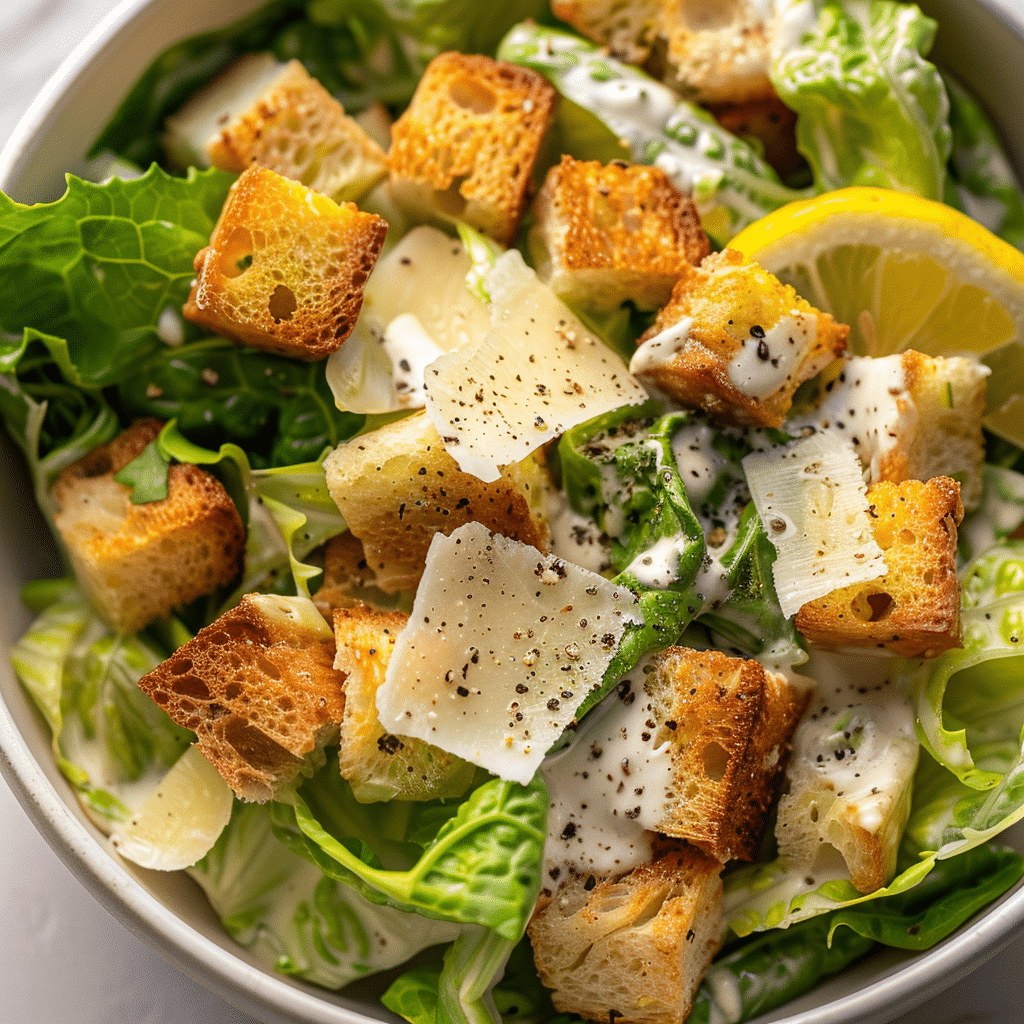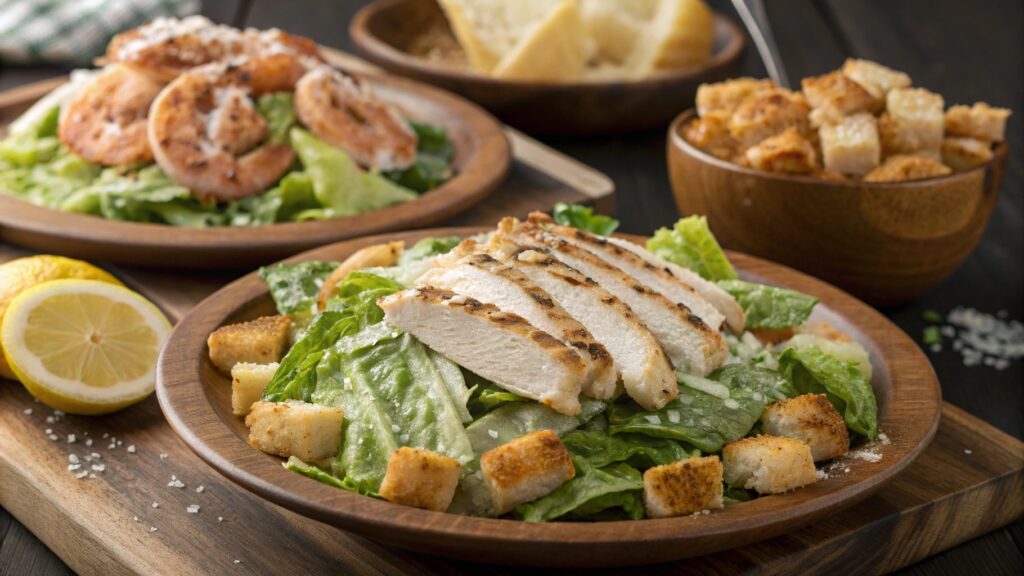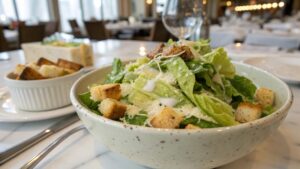
The Classic Restaurant Caesar Salad is a dish that has stood the test of time, gracing menus of fine dining establishments and casual eateries alike. Loved for its perfect balance of crisp romaine lettuce, creamy dressing, crunchy croutons, and savory Parmesan cheese, this salad has an irresistible appeal.
But where did it come from? How has it evolved over the years? And what makes a true Caesar salad? In this guide, we’ll explore the fascinating history behind the dish, break down its essential ingredients, and even give you a step-by-step guide to recreating a restaurant-quality Caesar salad at home.
We’ll also uncover common mistakes to avoid, variations that have gained popularity, and expert tips from top chefs. If you’re a fan of this legendary salad, get ready to dive deep into the world of Caesar salad perfection!
Table of Contents
The History and Origins of the Classic Caesar Salad
The Classic Restaurant Caesar Salad has a rich history that dates back nearly a century. Though it’s a staple in American cuisine today, its origins might surprise you. Let’s uncover the story behind this beloved dish.
The Birth of a Culinary Icon
Contrary to popular belief, the Caesar salad wasn’t born in Italy but in Mexico! It was created in 1924 by Italian-American restaurateur Caesar Cardini at his restaurant in Tijuana. Legend has it that on a busy Fourth of July weekend, Cardini found himself low on ingredients and had to improvise a salad with what was available—romaine lettuce, garlic, croutons, Parmesan cheese, eggs, olive oil, Worcestershire sauce, and lemon juice. The result? A masterpiece that soon became legendary.
Caesar Cardini: The Man Behind the Salad
Caesar Cardini was no ordinary chef. Originally from Italy, he moved to the United States but set up shop in Tijuana, Mexico, to escape Prohibition laws. His restaurant became a popular destination for Hollywood stars and American tourists looking for fine dining with a twist.
His original Caesar salad was prepared tableside, adding an element of theater to the dining experience. The dressing was made fresh and tossed with whole romaine leaves, which diners picked up and ate with their hands just as Cardini intended.
How the Original Recipe Has Evolved Over Time
Over the decades, chefs worldwide have put their spin on the Classic Restaurant Caesar Salad. While the core ingredients have remained the same, some notable changes include:
- Anchovies: Though Cardini’s original recipe didn’t include anchovies, many modern versions do, adding an extra umami punch.
- Chicken and Shrimp: Many restaurants now offer protein-packed variations, making the salad a hearty meal rather than just a side dish.
- Different Greens: While romaine lettuce remains traditional, some chefs experiment with kale, baby gem lettuce, or even grilled greens.
- Vegan Variations: With the rise of plant-based diets, some versions swap the egg yolk for vegan mayonnaise and use nutritional yeast instead of Parmesan.
Despite these variations, one thing remains true: the Classic Restaurant Caesar Salad is a dish that has captivated taste buds for nearly a century—and it’s not going anywhere anytime soon.
Key Ingredients in a Traditional Caesar Salad
The Classic Restaurant Caesar Salad isn’t just about tossing lettuce with dressing—it’s a careful blend of flavors and textures that create an unforgettable experience. Let’s break down the essential components of this legendary salad.
Crisp Romaine Lettuce: The Base of the Salad
Romaine lettuce is the foundation of a true Caesar salad. Its sturdy leaves provide the perfect crunch, holding up well against the rich dressing. When preparing a restaurant-style version, always use fresh, chilled romaine for the best texture. Some chefs even grill the lettuce lightly to add a smoky depth to the dish.
The Perfect Caesar Dressing: Anchovies, Egg Yolk, and More
A Classic Restaurant Caesar Salad wouldn’t be complete without its signature creamy dressing. While many bottled versions exist, nothing beats a homemade mix of:
- Egg yolks – The secret to a creamy, emulsified dressing.
- Anchovies – These little fish add an umami punch, though Cardini’s original version relied on Worcestershire sauce for a similar effect.
- Dijon mustard – Adds a slight tang and helps emulsify the dressing.
- Garlic – A bold flavor that gives the salad its signature kick.
- Lemon juice – Brightens the dressing and balances the richness.
- Parmesan cheese – Aged Parmesan adds nutty, salty complexity.
- Olive oil – A good-quality oil ensures a smooth texture.
When blended properly, these ingredients create a velvety dressing that clings to each leaf, elevating every bite.
Homemade Croutons: Crunchy, Buttery Perfection
No Caesar salad is complete without golden, crispy croutons. Store-bought versions work in a pinch, but making them at home is simple and rewarding. Toss cubed bread with olive oil, garlic, and a pinch of salt, then bake until golden brown. Some chefs opt for sourdough or ciabatta for added flavor.
Freshly Grated Parmesan: The Finishing Touch
Parmesan cheese isn’t just for garnish it plays a key role in enhancing the salad’s flavor. Aged Parmesan, when freshly grated, melts slightly into the dressing, adding a nutty, savory richness. If you want to go the extra mile, consider shaving large flakes for a more elegant presentation.
Each of these ingredients plays a crucial role in making a Classic Restaurant Caesar Salad a standout dish. Now, let’s move on to crafting this masterpiece at home!
How to Make a Classic Restaurant-Style Caesar Salad at Home
Making a Classic Restaurant Caesar Salad at home isn’t as complicated as you might think. With a few high-quality ingredients and the right technique, you can create a salad that rivals the best restaurants.
Step-by-Step Guide to Preparing the Perfect Caesar Salad

- Prep the Romaine Lettuce – Wash and dry the leaves thoroughly. For the best texture, chill them in the fridge for at least 30 minutes before assembling.
- Make the Dressing – In a bowl, whisk together egg yolks, minced garlic, Dijon mustard, lemon juice, and Worcestershire sauce. Slowly drizzle in olive oil while whisking to emulsify. Stir in finely grated Parmesan.
- Toast the Croutons – Toss cubed bread with olive oil and garlic, then bake at 375°F (190°C) until golden brown.
- Assemble the Salad – In a large bowl, toss the romaine leaves with the dressing until evenly coated.
- Add Croutons and Parmesan – Sprinkle with freshly grated or shaved Parmesan and top with the crispy croutons.
- Serve Immediately – A true Caesar salad is best enjoyed fresh before the croutons soften.
Tips for Making the Dressing from Scratch
- Use a blender or food processor – This helps emulsify the dressing faster, creating a smoother texture.
- Taste as you go – Adjust the acidity by adding more lemon juice if needed.
- Don’t skip the anchovies – Even if you think you don’t like them, they blend seamlessly into the dressing, adding depth of flavor.
Should You Use Raw Egg? Safety and Alternatives
Traditional Caesar dressing uses raw egg yolks to create its rich, creamy texture. If you’re concerned about food safety, here are a few options:
- Use pasteurized eggs – These have been heat-treated to kill bacteria.
- Swap for mayonnaise – It provides similar creaminess without the need for raw egg.
- Opt for a vegan dressing – A mix of tahini, nutritional yeast, and lemon juice can mimic the traditional flavor.
With these techniques, you’ll be able to craft a Classic Restaurant Caesar Salad that’s just as indulgent and flavorful as one you’d find in a high-end restaurant.
The Best Classic Caesar Salads from Restaurants Around the World
The Classic Restaurant Caesar Salad is a staple on menus across the globe, with each chef adding their own creative spin. Whether you prefer the traditional tableside preparation or a modern twist, these restaurants serve some of the best Caesar salads you’ll ever taste.
Top-Rated Caesar Salads in the U.S.
Some of the finest Classic Restaurant Caesar Salad experiences can be found in the U.S., where chefs take great pride in crafting the perfect balance of flavors. Here are a few standouts:
- The Grill, New York City – This upscale steakhouse prepares its Caesar salad tableside, just like in the old days. The anchovy-rich dressing and crisp romaine make it unforgettable.
- Zuni Café, San Francisco – Known for its focus on high-quality ingredients, Zuni Café’s version features house-made croutons and a dressing bursting with fresh garlic and lemon.
- Dan Tana’s, Los Angeles – A legendary Italian-American spot where the Caesar salad is tossed with a generous helping of Parmesan and served with whole Romaine leaves for a rustic touch.
International Takes on the Classic Caesar
While the Caesar salad has its roots in Mexico, its popularity has spread far beyond North America. Here are some unique versions found around the world:
- Harry’s Bar, Venice, Italy – This Venetian institution offers a refined take on the Caesar salad, incorporating Italian olive oil and aged Parmigiano-Reggiano.
- L’Atelier de Joël Robuchon, Paris – A Michelin-starred version featuring truffle-infused dressing and crispy Parmesan tuile for an elegant touch.
- Quintonil, Mexico City – A modern Mexican interpretation, adding locally inspired ingredients like roasted pepitas and cilantro.
Celebrity Chef-Approved Caesar Salads
Many famous chefs have taken their own approach to the Classic Restaurant Caesar Salad, turning it into a signature dish:
- Gordon Ramsay – His version includes grilled romaine lettuce for a smoky depth of flavor.
- Ina Garten – Prefers a lighter dressing made with Greek yogurt instead of raw egg yolks.
- Wolfgang Puck – Often adds crispy pancetta or prosciutto for an extra savory twist.
No matter where you go, a well-made Classic Restaurant Caesar Salad is always a crowd-pleaser. If you’re looking for more inspiration, check out other delicious salad recipes to elevate your next meal!
Common Mistakes When Making Caesar Salad (And How to Avoid Them)
Even though making a Classic Restaurant Caesar Salad seems simple, small missteps can lead to a lackluster dish. Let’s go over the most common mistakes and how to fix them.
Overdressing or Underdressing the Salad
One of the biggest mistakes people make is drowning the lettuce in dressing or not using enough. The key to a balanced Caesar salad is evenly coating each leaf without making it soggy. To get it right:
- Toss the salad gently with just enough dressing to lightly coat the leaves.
- If unsure, start with less dressing and add more as needed.
- Use tongs to mix everything thoroughly, ensuring the dressing is evenly distributed.
Using the Wrong Type of Lettuce
Romaine lettuce is the gold standard for a reason it’s sturdy, crisp, and holds up well against the creamy dressing. Using soft lettuces like iceberg or butter lettuce can make the salad too watery and limp. If you want a slight variation, try baby gem lettuce or even grilled romaine for extra flavor.
Skipping the Anchovies: Why They Matter
Many home cooks leave out anchovies, either due to personal preference or a lack of familiarity. However, anchovies are crucial to getting that deep umami flavor in the dressing. If you’re hesitant:
- Try anchovy paste for a milder taste.
- Start with just one fillet and gradually increase if you enjoy the flavor.
- Use Worcestershire sauce as a substitute, though it won’t have the same richness.
Neglecting the Croutons
Store-bought croutons might be convenient, but they rarely match the taste and texture of homemade ones. To make the best croutons:
- Use day-old bread like sourdough or baguette for a crunchier texture.
- Toss with olive oil, garlic, and salt before baking.
- Bake at 375°F (190°C) until golden brown stirring occasionally for even crispness.
A perfectly executed Classic Restaurant Caesar Salad relies on attention to detail. Avoid these mistakes, and you’ll have a restaurant-quality salad every time!
Variations and Creative Twists on the Classic Caesar Salad
The Classic Restaurant Caesar Salad is delicious on its own, but chefs and home cooks alike have found ways to put a unique spin on this iconic dish. From adding protein to swapping ingredients for dietary preferences, here are some popular variations to try.
Grilled Chicken Caesar Salad: A Protein-Packed Favorite

One of the most common twists on the classic version is the Grilled Chicken Caesar Salad. Adding juicy, charred chicken not only makes the salad more filling but also enhances its smoky flavor. Here’s how to make it restaurant-quality:
- Season the chicken well – Use a mix of olive oil, lemon juice, garlic, salt, and pepper.
- Grill to perfection – Cook over medium-high heat for 5–7 minutes per side until the internal temperature reaches 165°F (75°C).
- Let it rest – Allow the chicken to sit for a few minutes before slicing to keep it juicy.
This version is perfect for lunch or dinner, giving the Classic Restaurant Caesar Salad a hearty upgrade.
Vegan and Dairy-Free Caesar Salad Alternatives
If you follow a plant-based diet, you can still enjoy the flavors of a Caesar salad without the eggs, dairy, or anchovies. Here are some easy swaps:
- Dressing: Blend tahini, Dijon mustard, lemon juice, capers, and nutritional yeast for a creamy, umami-packed sauce.
- Parmesan alternative: Use nutritional yeast or finely ground cashews mixed with garlic powder.
- Croutons: Swap butter for olive oil when toasting the bread.
A vegan Classic Restaurant Caesar Salad keeps the crunch and zest of the original but is completely plant-based!
Restaurant-Inspired Caesar Salad with Unique Ingredients
Some restaurants get creative with their Caesar salads by adding unexpected ingredients. Try these twists at home:
- Seafood Caesar Salad: Top with grilled shrimp or seared salmon for a luxurious touch.
- Avocado Caesar Salad: Add creamy avocado slices to balance the tangy dressing.
- Spicy Caesar Salad: Toss in crushed red pepper flakes or a hint of sriracha for a kick.
With these variations, you can enjoy a Classic Restaurant Caesar Salad that fits your taste and dietary needs while keeping the essence of the beloved dish.
FAQs About Classic Restaurant Caesar Salad
Over the years, people have had many questions about the Classic Restaurant Caesar Salad, from its ingredients to preparation techniques. Here are answers to some of the most commonly asked questions.
What does the original Caesar salad have?
The original Caesar salad, created by Caesar Cardini in 1924, contained romaine lettuce, garlic, croutons, Parmesan cheese, olive oil, lemon juice, egg yolk, Worcestershire sauce, and black pepper. Interestingly, it did not include anchovies Cardini used Worcestershire sauce instead to create a similar umami flavor.
What are the ingredients in a traditional Caesar salad?
A traditional Classic Restaurant Caesar Salad includes:
- Fresh romaine lettuce
- Creamy Caesar dressing (made with egg yolks, anchovies, lemon juice, garlic, Dijon mustard, and olive oil)
- Crunchy homemade croutons
- Freshly grated Parmesan cheese
This combination creates the perfect balance of crunch, creaminess, and savory depth.
What are some common mistakes when making Caesar salad?
Even though a Caesar salad is simple, mistakes can happen. Some of the most common errors include:
- Overdressing the salad – Too much dressing makes the lettuce soggy.
- Skipping the anchovies – They add a necessary umami kick.
- Using low-quality croutons – Homemade is always better.
- Not tossing the salad properly – Every leaf should be evenly coated.
Avoid these, and your Caesar salad will taste just as good as the best restaurant versions.
How does Gordon Ramsay make Caesar salad?
Celebrity chef Gordon Ramsay has his own spin on the Classic Restaurant Caesar Salad. Some of his key techniques include:
- Grilling the romaine lettuce to add a smoky flavor.
- Using a rich, garlicky dressing with a hint of spice.
- Adding crispy bacon or pancetta for extra crunch and saltiness.
If you love a bold, flavorful salad, Ramsay’s method is worth a try!
Classic Restaurant Caesar Salad – Perfect Pairings and Serving Suggestions
A Classic Restaurant Caesar Salad is a star on its own, but pairing it with the right dishes and drinks can elevate the experience. Whether you’re serving it as an appetizer or a main course, here are some of the best pairings to complete your meal.
Best Wines to Pair with Caesar Salad
The bold flavors of a Classic Restaurant Caesar Salad call for wines that can complement its richness without overpowering it. Here are some great options:
- Chardonnay – A lightly oaked Chardonnay brings out the creamy texture of the dressing while balancing the tangy lemon and Parmesan.
- Sauvignon Blanc – Its crisp acidity cuts through the richness of the dressing and enhances the freshness of the romaine.
- Pinot Grigio – A refreshing choice with citrus and mineral notes that work well with the zesty dressing.
If you prefer red wine, go for a light-bodied Pinot Noir or a Beaujolais, which won’t clash with the salad’s acidity.
Perfect Side Dishes for Caesar Salad
If you’re serving the Classic Restaurant Caesar Salad as a main dish, pairing it with the right sides can create a balanced meal. Some great options include:
- Garlic Bread or Focaccia – The crispy, buttery texture complements the creamy dressing.
- Grilled Vegetables – Zucchini, bell peppers, and asparagus add a smoky depth to the meal.
- Soup Pairings – A warm bowl of tomato basil soup or French onion soup pairs beautifully with a fresh Caesar salad.
- Seafood Additions – Grilled shrimp or seared salmon make excellent protein choices for a hearty version of the dish.
With the right wine and side dishes, your Classic Restaurant Caesar Salad can go from a simple starter to an unforgettable meal.
Final Thoughts on the Classic Restaurant Caesar Salad
The Classic Restaurant Caesar Salad is more than just a salad it’s a timeless culinary masterpiece. From its humble beginnings in a Mexican restaurant to becoming a staple on menus worldwide, this dish has stood the test of time.
Why the Caesar Salad Remains a Favorite
Few salads achieve the perfect balance of crisp, creamy, tangy, and savory like the Caesar does. Whether served tableside at a fine-dining restaurant or made fresh at home, its appeal is undeniable. The key to a great Classic Restaurant Caesar Salad lies in quality ingredients, proper technique, and attention to detail.
Try It at Home or in a Top Restaurant
Now that you’ve explored the history, variations, and best techniques for making a restaurant-quality Caesar salad, it’s time to try it for yourself! Whether you opt for a classic version or put a unique twist on it, you’ll be enjoying a dish that has delighted food lovers for nearly a century.
For more delicious recipes and culinary inspiration, be sure to check out my Pinterest other classic dishes that pair perfectly with a Caesar salad. Happy cooking! 🍽️
Classic Restaurant Caesar Salad
Equipment
- Mixing bowl
- Whisk
- Baking Sheet
- Oven
Ingredients
For the Salad
- 2 heads romaine lettuce chopped
- 1/2 cup Parmesan cheese shaved or grated
For the Dressing
- 2 egg yolks or use pasteurized egg yolks
- 2 cloves garlic minced
- 1 tsp Dijon mustard
- 1 tbsp Worcestershire sauce
- 2 tbsp lemon juice freshly squeezed
- 1/2 cup olive oil
- 2 tbsp anchovy paste or 4 finely chopped anchovy fillets
- 1/4 tsp black pepper freshly ground
For the Croutons
- 2 cups bread cubes sourdough or French bread
- 2 tbsp olive oil
- 1/2 tsp garlic powder
Instructions
- Preheat oven to 375°F (190°C). Toss bread cubes with olive oil and garlic powder, then bake for 8-10 minutes until golden brown.
- In a mixing bowl, whisk together egg yolks, minced garlic, Dijon mustard, Worcestershire sauce, and lemon juice.
- Slowly drizzle in olive oil while whisking continuously until the dressing is thick and creamy.
- Stir in anchovy paste and black pepper, then whisk until well combined.
- In a large bowl, toss the romaine lettuce with the dressing until well coated.
- Top with croutons and Parmesan cheese. Serve immediately.

